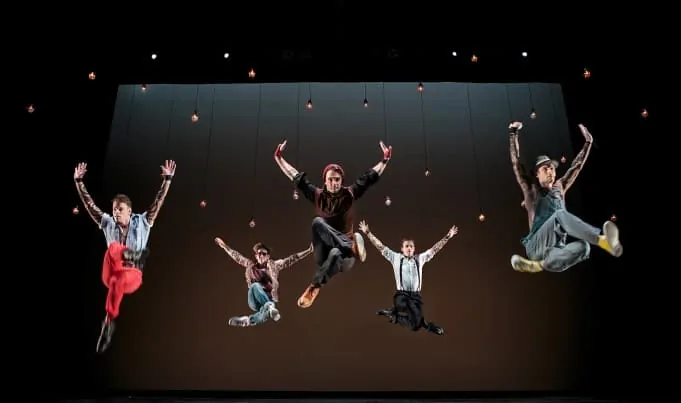Smuin Ballet’s 21st season brought three programs: “Untamed,” “Uncorked,” “Unlaced.” With them, we’re tantalized by a promise of vitality, wildness, an impulse to move forward. The last of these programs, “Unlaced,” opened Friday for a two week run at the Yerba Buena Center for the Arts before moving on to Walnut Creek, Carmel, and Mountain View.
Petal, (choreography by Helen Picket; score by Philip Glass and Thomas Sets) begins with a long silence as the audience sits in a dim house for whatever pre-ordained interval suffices to induce maximal searing when luminescent yellow light floods the stage.
Four shirtless males in blue pants paired with four women in yellow ornamented leotards, an explosion of in-the-moment vitality, mirrored in vibrant pas de deux, pas de trois, solo and group pieces.
At sporadic, seemingly dissociated moments, a figure separates, hesitates, reflects back, and moves off stage, even as others join the group, changing the color of the dance. This reflecting back is echoed in a deepening lighting palette, from luminous melon to deeper hues.
The whole thing happens so organically, so subtly, that it seems to originate somewhere beyond the choreographer’s active imagination, until you realize that this moment of reflection focuses the energy and drives the whole thing forward.
A momentary pause for scene change allows the audience to sit with Petals a bit longer before moving attention to the second dance of the evening, the balcony pas de deux from Romeo and Juliet, which opened against a dark and starry sky, a decided contrast to that vibrant color and light of Petal.
Meticulously choreographed, this dance invites repeated watching so you can pick up on more details, like the draping of Erin Yarbrough’s skirt and how effectively costumer William Pitkin’s designs serve the work.
The balcony pas de deux in Romeo and Juliet is an important piece for the Smuin Ballet, created by Michael Smuin in 1976. Danced to Prokofiev’s Romeo and Juliet, it appeared on the PBS series Great Performances. Here though, it was the weak link of the evening, which is more a reflection on how it felt in the program, rather than the dance itself.
Yarborough, who partnered with fiancé Jonathan Powell, seemed the stronger of the two, perhaps because Michael Smuin coached her in the role some seven-odd years ago. Even dance neophytes can marvel at the stillness of her body, even in quick tiny, seemingly punctuated en pointe travelling steps.
Hearts Suite, the third dance of the evening, was also choreographed by Michael Smuin. Like that which preceded it, Hearts Suite was excerpted from a longer work, Hearts (Le Ballet des Coeurs), which in turn, is based on the 1945 film Les Enfants du Paradis by Marcel Carné.
Susan Roemer danced the role of beautiful courtesan Garance, and Ben Needham-Wood, appeared as the tragic mime Baptiste on Friday, although they share the role across performances, with Nicole Haskins and Jonathan Powell.
The same tension between unity and separation on display in Petals operates here, only more obviously. Instead of a thoughtful reflection back, signaling some sense of autonomy, here it’ s yearning through a filter of separation. The distance between Garance and Baptiste increases, with Baptiste’s knowledge that he’s forever fated to the mime’s simulacrum existence, yearning for the living breathing Garance.
Garance, costumed in the courtesan’s red, embellished with black netting, is a study in contrasts with Baptiste, in white flowing clown pajamas and white face.
Energy flows cleanly in this surprisingly unified work
The Edith Piaf vocal score was sung on opening night by legendary French vocalist Raquel Bitton, accompanied by Donald White. Bitton is a heart-stopping singer, with a profound sense of moment and phrasing. Still I worried about feeling torn between watching her and watching the dancers. No worries here, because these elements were so tightly integrated that they created a harmonious whole that didn’t leave you with low level anxiety over possibly missing something really good while your attention was elsewhere.
The capper of the evening was the world premiere of Adam Hougland’s Ask Me, in which 14 dancers moved to music by Joan as Policewoman (Joan Wasser).
Hoagland’s work seemed so subtly rooted in musicals that I mentally drew lines from the West Side Story choreography, and the feel of visual art by WPA artists in the ’30’s, to this startling good work that seems to draw from these sensibilities while remaining totally different them and so wholly in the moment that it could almost feels like the beginning of a new dance vocabulary.
Energy flows cleanly in this surprisingly unified work, which builds subtly on ideas throughout the performance to voice an unabashed reassertion of self.
Various very knowledgeable folks remarked that while this is very different from anything Michael Smuin ever contemplated, Smuin would be smiling with delight from some terpsichorean heaven in response to his eponymous company performance thereof. As the last dance of the season, it deposits the audience back in the here and now, moving onto the San Francisco streets, curiously satisfied.



